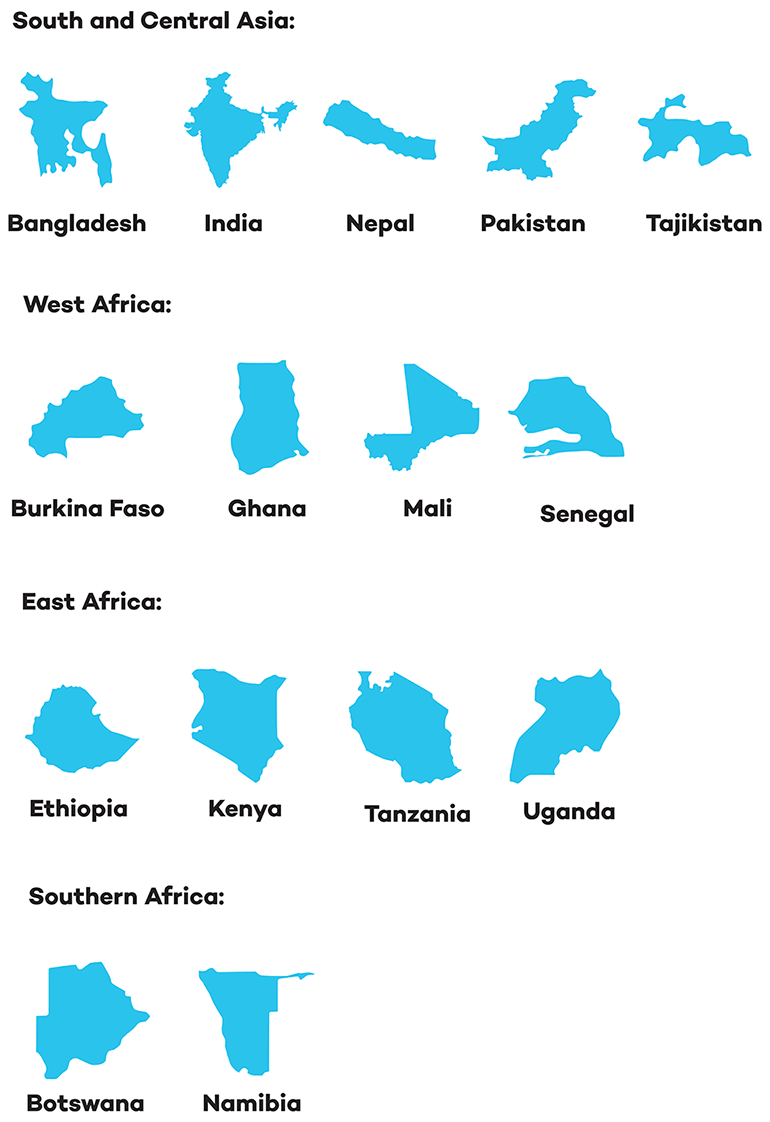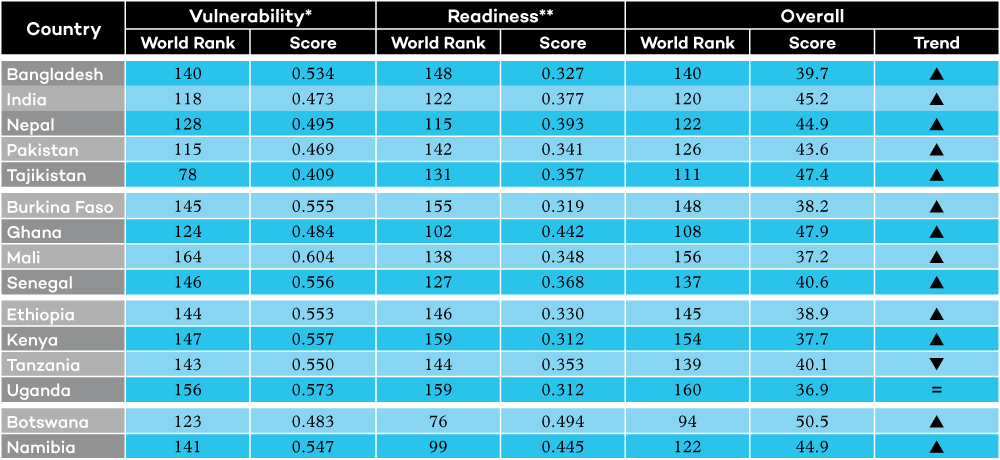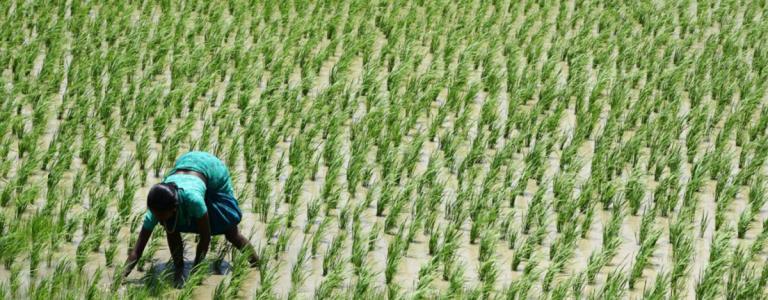How Are Vulnerable Countries Adapting to Climate Change?
We examined adaptation action in 15 African and Asian countries, vulnerable to the impacts of climate change and are the least ready to respond.
Introduction
The International Institute for Sustainable Development recently undertook a standardized review for the Collaborative Adaptation Research Initiative in Africa and Asia, providing a baseline picture of national adaptation policy and practice in developing countries. What follows is an overview of the trends that emerged from that review—along with our key takeaways. For a more detailed discussion our findings, read our briefing note.
What are trends in adaptation preparedness?
We examined adaptation action in 15 African and Asian countries. These countries are highly vulnerable to the impacts of climate change and are among the least ready to respond to its impacts.

The good news is that, for the most part, these countries are becoming better prepared. This is reflected in the findings of the University of Notre Dame’s Global Adaptation Index (ND-GAIN), which uses a common set of indicators to measure countries’ vulnerability to climate change and their capability to respond.

What are common adaptation priorities?
Although the countries reviewed differ significantly in terms of their population size, geography, economic profiles and exposure to climate risks, they share many of the same adaptation priorities.
Agriculture under pressure
Every single one of the countries surveyed identified the agricultural sector as a priority. The response varied depending on national circumstances; however, some common areas for action included better drought-tolerant seeds, expanded irrigation systems and improved access to seasonal weather forecasts.
Protecting freshwater supplies
Ensuring access to freshwater supplies was another shared priority. Countries with large arid and semi-arid regions want to capture and store available surface and groundwater resources. In coastal areas, countries are protecting freshwater from saline intrusion and damage to water infrastructure from strong storm surges.
Climate impacts on health
Nearly all of the countries surveyed want to raise awareness in their healthcare systems about the risk climate change poses, and increase the capacity of health care workers to better manage these impacts. Countries also see the need to strengthen their ability to reduce the incidence of water- and vector-borne diseases like cholera and malaria that could become more prevalent as the climate changes.
Risks posed to the energy sector
A number of countries highlighted the risk climate change poses for their energy sector, particularly those that derive a significant portion of their electricity from hydropower. They see the need to diversify their energy systems, such as by expanding geothermal, solar and biogas production. They also want to improve energy efficiency and expand the adoption of efficient technologies.
Fisheries and local livelihoods
Fisheries (marine, freshwater or aquaculture) also was prioritized by several countries, reflecting the importance of this industry for local livelihoods and diets. Countries with marine fisheries are interested in improving fish management and promoting sustainable fish farming. Similarly, countries with inland fresh water fisheries are focused on promoting integrated fish management and increasing aquaculture production.
Reducing risks from extreme weather
Disaster risk reduction and the capacity of countries to cope with extreme weather events, such as floods, droughts and cyclones, was also highlighted. Countries are interested in strengthening their hydro-meteorological institutions to prepare climate forecasts and projections and improving early warning and disaster risk management systems.
What strategies are countries using to respond to climate risks?
The countries surveyed acknowledge the need to prepare for the impacts of climate change. Their approach, however, varies. Many countries have identified climate change as a key issue in their national development strategies. Some are engaged in National Adaptation Plan processes, while others have already produced standalone plans. For example:
Kenya recently passed a Climate Change Bill, has in place a National Climate Change Strategy and National Climate Change Action Plan, and has prepared a draft national climate change framework policy and a draft climate finance policy. These identify the government’s priority actions for increasing resilience to climate change. They also enable the government to establish specific institutions empowered to coordinate and implement these priority actions.
Bangladesh has prepared a climate change strategy and action plan, with funding earmarked for their implementation. The Bangladesh Climate Change Trust Fund was established and funded by the Government of Bangladesh, while a second fund, the Bangladesh Climate Change Resilience Fund, is financed by donors. Both funds provide millions of dollars to invest in actions like river bank protection, afforestation and disaster management.
Burkina Faso published a National Adaptation Programme of Action in 2007 and released its National Adaptation Plan in 2015. It has also established a National Council for the Environment and Sustainable Development under its Ministry of Environment and Sustainable Development to coordinate and harmonize, among other issues, climate change planning and action. However, Burkina Faso—as one of the least developed countries globally—lacks the capacity and financing required to implement its adaptation plans.
Overall, less progress is occurring at the sub-national level in the countries surveyed.
Sub-national adaptation action is highly dependent on country’s level of decentralization. In countries that have devolved significant responsibility to lower levels of governments, systems and structures may exist to advance adaptation action. However, these lower levels of government often lack the capacity to manage these responsibilities.
In 2009, for instance, India requested that states develop a State Action Plan on Climate Change and developed a common framework document to help them identify and plan adaptation and mitigation priorities that align to the country’s National Action Plan on Climate Change. Insufficient institutional capacities, budgetary constraints, and inadequate attention to the plans’ potential to support climate resilient development, however, has impeded the potential benefits of these plans.
In 2014, Ghana updated its guidelines for medium-term development planning at the district and municipal level to including climate change. Local governments are tasked with developing medium-term plans that link climate change adaptation and disaster risk reduction, and that incorporate community-level adaptation plans. A Local Climate Adaptive Living Facility supports some climate change adaptation activities on a pilot basis. While these initiatives create opportunities, their effectiveness is constrained by local governments’ significant capacity and resource challenges.
We also reviewed projects and programs supported primarily by bilateral and multilateral organizations. The number of projects varied significantly among countries: very few discrete adaptation projects are being implemented in Botswana, for instance, while a sizable number of multi-million dollar projects are being implemented in Bangladesh.
Agriculture was the focus of the largest proportion of projects. These generally aim to help smallholder farmers build their resilience to climate change by changing agricultural practices, diversifying livelihoods, promoting sustainable landscape management, advancing gender equality and improving access to climate information.
A number of other projects are working to build the capacity of national and sub-national governments to manage the impacts of climate change, strengthen disaster risk management systems, and improve capacity to generate and access climate information.
What are the key takeaways?
Our review for CARIAA program provided a number of insights into existing trends within efforts to meet the adaptation needs of developing countries. Here are the most significant trends.
- Progress varies between countries—but not for the reasons you might think. Notably, differences among countries cannot be attributed to development status. Countries with higher levels of human development, such as Botswana and Pakistan, are less actively engaged in adaptation planning than lesser developed countries such as Bangladesh, Ghana and Uganda. Adaptation progress also cannot be attributed solely to differences in exposure to climate risk and understood vulnerabilities to climate change. Rather, progress appears to be driven primarily by senior government leadership, and influenced by the priorities of development assistance agencies in each country.
- Countries share a focus on agriculture. Across all of the countries surveyed, agriculture was identified as a priority sector for adaptation. Agriculture also emerged as the focus of the largest proportion of recent adaptation projects and programs. This is perhaps unsurprising given the climate-sensitivity of crop and livestock production, governments’ desire to meet the food security needs of their people, and the continuing prominence of agriculture as a source of employment in many developing countries.
- Adaptation planning is lacking at the sub-national level. The capacity of sub-national governments to identify, prioritize, mainstream and implement adaptation actions appears to be limited. Particularly in countries where decentralization is underway, more effort is needed to enhance the ability of sub-national governments, communities and local institutions to take on their devolved responsibilities. In other countries, greater emphasis may be placed on clarifying the roles and responsibilities of different levels of government and establishing effective institutional arrangements.
- There is an absence of monitoring and evaluation systems. These are needed to assess the effectiveness of current investments in adaptation action by developing country governments and their development assistance partners; monitor progress in implementing adaptation policies, plans and programs; and identify gaps and areas for refinement. Significant investment is needed to establish, manage and utilize monitoring and evaluation systems.
- Big gaps are found in some priority sectors. Insufficient attention is being given to meeting adaptation needs in some sectors recognized as being particularly vulnerable to the impacts of climate change. These include health, forestry and fisheries. The reasons for this continuing pattern are unclear; they could be a reflection of, for example, national governments’ internal prioritization processes, a desire by sector officials to focus on immediate development needs, or the absence of substantial international financing for adaptation in these sectors.
To learn more about IISD’s work on climate change adaptation, please visit our climate change adaptation web page.
You might also be interested in
Toolkit for Monitoring, Evaluation, and Learning for National Adaptation Plan Processes
This toolkit provides practical guidance for the development and continuous improvement of MEL systems for national adaptation plan processes to government teams and practitioners working on adaptation.
Progress on Vertical Integration in National Adaptation Plan Processes
This synthesis report presents an analysis of how countries are advancing vertical integration in national adaptation plan processes.
Four Key Elements to Ensure a Successful Global Goal on Adaptation
As the final rounds of negotiations on the GGA kick off at COP 28, a looming question remains: Will it be comprehensive enough for countries to implement in the years ahead?
Public Engagement on Climate Change Adaptation
This report provides an introduction to public engagement on climate change adaptation for decision-makers involved in leading national adaptation plan (NAP) processes.
